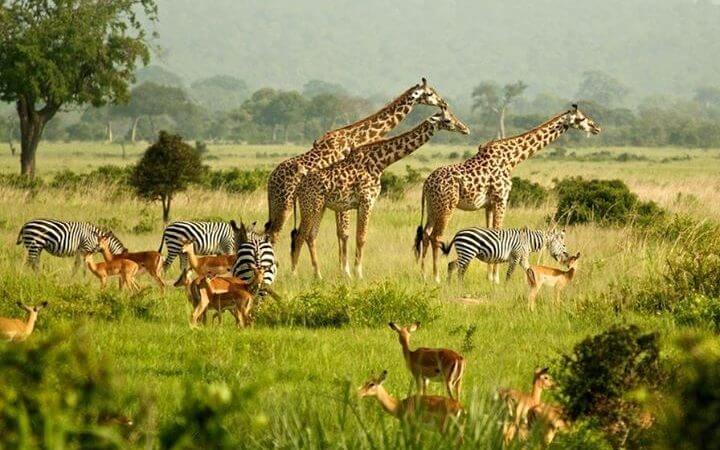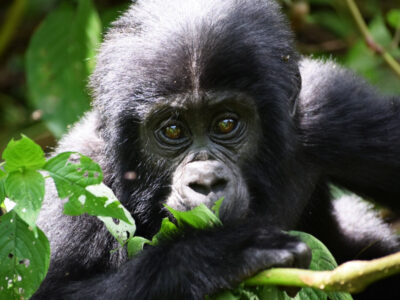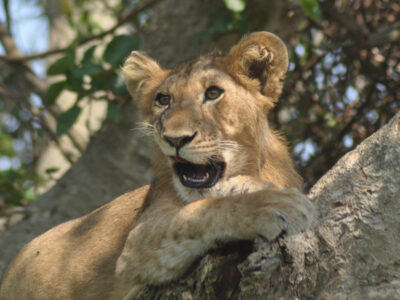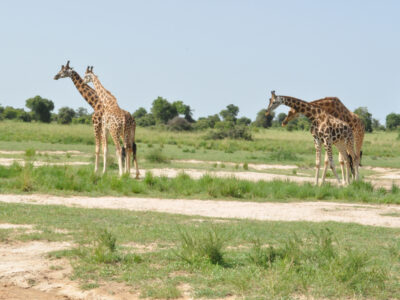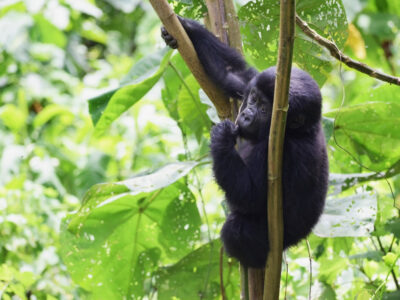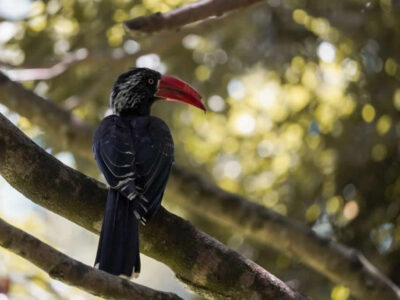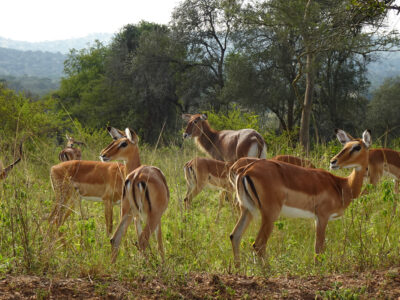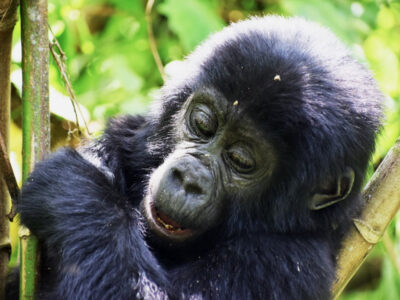Eastern Africa’s Uganda is a stunning nation bordered by Kenya, South Sudan, the Democratic Republic of the Congo to the east, Rwanda, and Tanzania. Uganda is a landlocked nation with no access to the sea, but it is encircled by the Great Lakes region, which includes Lake Edward, Lake Albert, and Lake Victoria. Uganda is a plateau country with mountains and normally has a tropical climate with two seasons (rainy and dry).
There are many attractions in Uganda, including mountains, lakes, rivers, and most importantly, the wild creatures that may be found in the national parks. When you visit Uganda’s national parks, you are guaranteed to catch a glimpse of the majority of them with a little bit of luck or good fortune. Some of the most alluring species are as follows:
African Elephant

Uganda is a home of both African elephants and smaller savanna elephants, they are big in nature. It is noted that elephants are the largest animals on land and their lifespan is around 70 years. One big elephant can eat up to 350 kgs of vegetation grass and 200litres of water in a single day since they move long distances to graze.
A female elephant has a gestation period of 2 years (an animal with the longest gestation period of all mammals) and gives birth to one calf every nine years. They are friendly, caring, and intelligent with the highest intelligence quotient (IQ) and they can socialize with human beings.
African elephants in Uganda can be seen in Murchison falls national park, Queen Elizabeth national park, Bwindi impenetrable national park, Kibale national park, and in word life education centers, here around30 in numbers per afternoon.
Baboons
It is an assurance to every person visiting Uganda to see baboons and they are commonly spotted reason being they are omnivorous, they eat whatever they find from leaves, roots, grass, fruits, flowers, and birds, and insects, their bodies vary between 20-40 inches long not including the tail, they come into fight and conflicts with human beings through raiding gardens of plantains.
They can be found in most of the national parks since they prefer living in tropical forests and semi-arid climates such as Queen Elizabeth national park, Murchison falls national park, Bwindi national park, Kibale national park, and can easily be traced on road pavements.
Rothschild Giraffes
Giraffes are long-legged, cud-chewing creatures with long necks and irregularly shaped brown patches on light backgrounds on their coats.
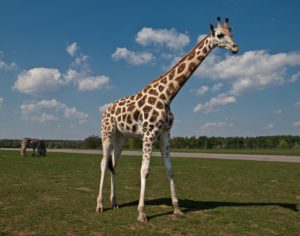
The tallest terrestrial animal, giraffes can reach heights of up to 5.5 meters, making their legs alone 6 feet taller than the majority of people. They cover a short distance at a speed of roughly 60 km/h. They wander in herds that are either related to their young or are not related to males and are gregarious and congregate in groups. They are calm and gentle in character.
The male giraffe will battle other males in order to establish his supremacy and acquire access to the ladies. Since they eat plants that are rich in water, they can go 2-3 days without water in the wilderness.
Giraffes don’t live in territorial groups of more than 20, and they have home ranges as small as 85 square kilometers in rainy places and as large as 1,500 square kilometers in arid areas. The communal habit of the animals reportedly enables heightened surveillance against predators. Because of their keen vision, when one of the giraffes looks for a threat a mile away, the others turn to face that direction as well.
Because of their short neck, giraffes cannot touch the ground. It is forced to bend or expand its front legs unnecessarily in a way to reach the surface for a sip of water.
Amazingly, giraffes only require 5 to 30 minutes of sleep every 24 hours despite spending the majority of their lives standing up. They even sleep and give birth while still upright. They frequently accomplish it by taking brief sleep that may just last a minute or two at a time.
The giraffe’s spots resemble a person’s fingerprints quite substantially. Despite being members of the same species, no two giraffes have exactly the same pattern.
Although it was once believed that giraffes were silent, it has now been discovered that they actually generate a variety of sounds, including bellowing, snorting, hissing, flute-like noises, and low-pitched noises that are inaudible to humans.
The finest places to see giraffes include Uganda Wildlife Education Centers, Kidepo Valley National Park, Lake Mburo National Park, and Murchison Falls National Park, where there are over 1000 of them.
African Buffalo
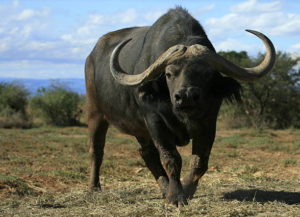
These are the most dangerous animals in Uganda due to their aggressiveness in nature, they live in large herds of over hundreds, but that number jumps up to the thousand during the rainy season and herds move in the same direction wherever they go. They are mostly traced around the waters as they keep on paddling around the lakes and rivers and graze during the night. They live and feed on vegetation (grass) and surprisingly like domestic cows, buffalos do cud. They can run up to 13 miles per hour and their lifespan in the wild is 22 years.
Buffalos spend most of the year in herds and gathering in large groups helps dissuade predators like lions, leopards, and African wild dogs. Meanwhile, calves spend up to a year and a half suckling and are completely dependent on their mothers during this time.
The African buffalos have horns that can grow and reach seven feet from tip to tail. These Horns can help distinguish age and sex. In large adult males, the horns meet in the middle of their heads and are joined by a hard shield. The horns are used for defense and to determine dominance for mating. Not like the females who have horns that are narrower and smaller.
They are found in Lake Mburo National Park, Queen Elizabeth National Park, Murchison Falls National park, and other parks.
Mountain Gorillas
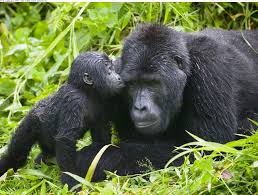
These are two different primates though look the same in appearance, there is a slight difference between them. The mountain gorilla is slightly bigger than the chimpanzee and has small ears placed on the back of their heads whereas chimpanzees have big ears placed 0n their back. To learn more about these gentle giants of the forest, you can read more interesting facts about gorillas in a different article.
Uganda is the luckiest country to inhabit gorillas since they are so scarce almost 1000 are found in Africa. Mountain Gorillas share 98% of their DNA with humans and are called our cousins and are believed to be shy. Half of the Mountain gorillas in Africa can be found mainly in Bwindi impenetrable national park and a few in Mgahinga national park.
Chimpanzee
On the other hand, chimpanzees are so friendly animals that you can get close and socialize and bond with them. It is believed that they share almost 99% of their DNA with humans and that’s why they behave like people in real life such as the use of tools to feed, hunt, and communicate through hand and facial signs.
Chimpanzees are found In Kibale National Park, Kyambura Gorge, Kalinzu forests, and Budongo forest in the Murchison fall conservation area. The best chimpanzee experience, by far, is Kibale Forest which is located in the southwestern region of the country. This forest is home to approximately 1,500 chimpanzees and has, near enough, a 100 percent success rate of seeing them.
African Leopard
They are not easy animals to spot in Uganda since they move in isolation hence it’s a jaw-drawing experience to see a leopard in Uganda simply because they disguise mostly in trees and long grass where they cannot be spotted and prefer moving alone. Leopards rest in trees and thick bushes during the daytime and are the most dangerous animal in the cat family that feeds on fresh (hunt small and weak animals to survive). They are very fast and can run at a maximum speed of 58km/h, their lifespan is between 12-17 years, and the gestation period is around 3 months giving birth to 2-3 cubs
Leopards can be found in Kidepo National Park, Queen Elizabeth National Park, Murchison Falls National Park Semuliki National Park, and Lake Mburo National Park.
African Lion
A lion is one of Africa’s big five safari animals in the park, they are thrilling and interesting to see due to their beauty and power, they are named king of the jungle and if happen to spot one on your safari it’s a memorable experience. A male lion is distinguished with a mane that fur spreads all over the neck and identified with a big head and body with short legs while a lioness is portable slender and shorter compared to a male. Lions live to a maximum of 16 years in the wild and move in groups called pride.
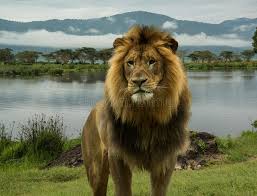
Lions are the only cat family that lives in groups of up to 30 members depending on the availability of food and water resources. During mating, a female lion takes 3-4months pregnant and delivers between 2-6 cubs.
Female lions are the main hunters. While they’re out looking for food, the males guard the pride’s territory and their young cubs. After the hunt, the group effort often degenerates into squabbling over the sharing of the kill, with cubs at the bottom of the pecking order. Young lions do not help to hunt until they are about a year old. Lions will hunt alone if the opportunity presents itself, and they also steal from hyenas and wild dogs. A lion’s roar can be heard up to eight kilometers away while the Lions’ scent marks their territory, using their urine to create a border.
In Uganda, you can find tree-climbing lions in the Ishasha sector of Queen Elizabeth National Park although not all parks have lions the best places to visit are Murchison Falls National Park, Kidepo Valley National Park, and a few in Lake Mburo National Park.
Hippopotamus
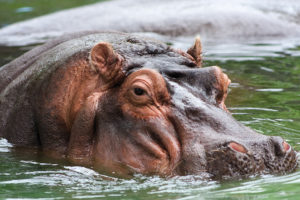
Hippopotamus are semi-aquatic animals (live both in water and land) mostly found in lakes and rivers good enough Uganda is blessed with hundreds of water bodies where they can be found such as lake Albert, lake Edward, and Lake George, and others, the word hippopotamus means “river horse” in Greek.
Although hippos live near water, it is believed that they don’t swim due to heavy weight but rather they walk along the bottom where they can flood for up to six minutes without breathing. They protect their bodies from the sun by spending the entire day in the water and graze during the night hours.
Hippos are dangerous animals and when they are chasing after something, they can charge up to 40km/h. They use their nostrils to breathe leaving the entire body merged in deep waters. The female hippo spends around 8 months pregnant and delivers one calf, their lifespan is about 30-40 years. Since they live near water, they can easily see on a boat trip to Murchison Falls, the Kazinga channel on Queen Elizabeth national park, Lake Mburo, and Semuliki Wildlife Reserve on Lake Albert.
Spotted Hyena
Hyenas are the most common carnivores in Africa and the chances of seeing them on your trip to Uganda national parks is high and commonly known as laughing hyena due to their cackling laugh when excited. They have long front legs and a powerful neck for carrying and pulling up the fresh. Their lifespan is about 25 years in the wild and the female hyena spends between 3-4 months pregnant giving birth to 2-4 cubs.
They are active both day and night and associate with human beings by chasing their domestic animals, they eat anything and consume the entire animal including the bones and skin, and tend to move in a group of 2-5 members, when hunting they chase the prey for some kilometers around 60km/h and have an abnormal/ weird sound they make as a way of alerting fellow members about the danger or food point and the sound can reach up to 3 miles away.
To see these beautiful interesting wild animals, you can visit Lake Mburo national park, Queen Elizabeth, Kidepo national park and Murchison falls national park.
Uganda Kob
This is known as the National animal of Uganda as it features on Uganda’s coat of arms with a grey crowned crane as a true representation of Uganda’s abundant wildlife. Uganda is well known for authentic wildlife safaris with lots of animals that can be seen in their natural habitat. One of the many animals you will see so much of is the Uganda Kob.
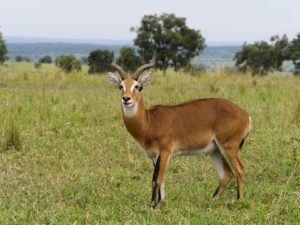
They act as a source of food to lions, leopards, hyenas, and wild dogs, they live in small groups though sometimes they come in a big number of about 1000 kobs. The male kob whistles as a way of protecting their territory and pursuing the females.
A Uganda kob has a reddish-brown color that differs it from other kobs around different countries, they feed mainly on lowland grass, the female kob can produce at 13 years spending about 8 months pregnant as they give birth to one calf, and its lifespan is low as it spends almost 17 years in the wild.
Male kob has horns and is slightly larger than a female one. Kobs can be found in most of the parks including Murchison Falls and Queen Elizabeth National Parks. Unlike other types of antelopes, the males use a softer ‘human’ approach towards ‘courting females.’ The male will not force the female to become part of his herd during and after mating, rather he ‘convinces’ her to stay by making soft noises and whistling through the nostrils. This sound resounds across the entire breeding area.
Conclusion
When planning for a Ugandan safari, these 10 safari creatures ought to be on your bucket list. The likelihood of seeing them increases during your tours of any of Uganda’s national parks, but they shouldn’t be the only ones; what these are is merely a fantastic beginning and is by no means sufficient. Although Uganda does not have as many animals as you might expect, it nonetheless competes with other African nations as a great place to watch wild animals year-round thanks to the comfortable tropical environment. A wider variety of fauna, including monkeys, reptiles, and creatures of the savannah, can be seen more frequently.

